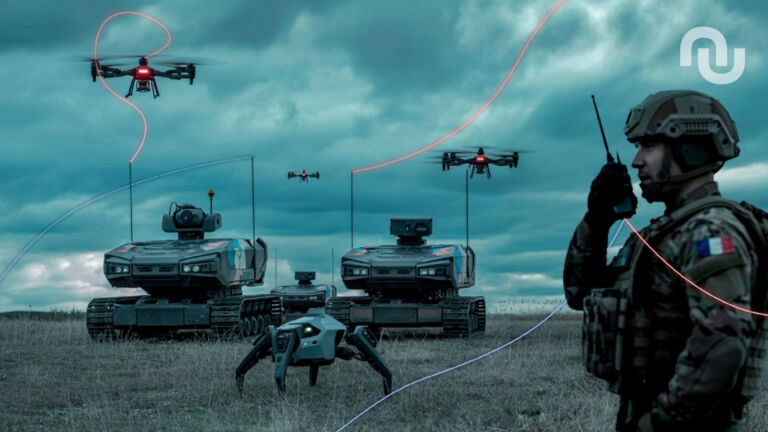Publié : 25 November 2025
Actualisé : 10 hours ago
Fiabilité : ✓ Sources vérifiées
Je mets à jour cet article dès que de nouvelles informations sont disponibles.
📋 Table of Contents
🚀 The Future is Now (and it’s French)
Brace yourselves, because the future of defense is no longer a sci-fi movie concept, but a reality taking shape before our very eyes – or rather, above our heads and on our ground. Forget the fantasies of giant robots; the real revolution is more discreet, yet infinitely more strategic. France, my friends, is preparing a technological game-changer, and it’s called Pendragon.
Imagine for a moment: drones buzzing, ground robots patrolling, all orchestrated by stunning artificial intelligence, supervised by a single human. No, this isn’t the pitch for a new blockbuster; it’s Project Pendragon, and it’s on the verge of redefining warfare as we know it.
The key takeaway: Project Pendragon aims to deploy an autonomous robotic unit by 2027, capable of replacing a section of around forty soldiers for tactical missions.
🐉 Pendragon: Who Leads This Swarm?
The name itself, Pendragon, is an invitation to myth, evoking the legendary King Arthur. But here, the dragon is not a myth; it’s a concrete force, a ‘chief of chiefs’ for an army of machines. So, what exactly are we talking about? A swarm of aerial and ground drones, powered by AI that will be able to make decisions, execute reconnaissance, logistics, and even destruction missions, all under the watchful eye of a remote human operator.
The Ministerial Agency for Artificial Intelligence in Defense (Amiad), based near Rennes, is the brain behind this operation. It’s in their ultra-secure facilities that these technological marvels are being tested, learning to work together like a mechanical symphony.
This particularly ambitious project has even been compared to ‘Gerboise bleue,’ the code name for France’s first nuclear test.
🤯 Why is This “Revolution” So Important?
The comparison to France’s first nuclear test isn’t just for show. It highlights a colossal paradigm shift. Until now, drones were often extensions of a soldier, a remote eye or arm. With Pendragon, we’re moving to an autonomous entity, capable of operating independently under supervision, thereby freeing up human forces for other tasks or protecting them from danger.
Important: One of Pendragon’s driving forces is the analysis of recent conflicts, particularly in Ukraine, where the massive use of drones has demonstrated both their effectiveness and the vulnerability of human operators. An autonomous swarm is a direct response to these challenges.
Furthermore, a swarm offers increased resilience against electronic jamming, a major problem on modern battlefields. If one drone is neutralized, the others continue. It’s the strength of numbers and distributed intelligence.
🛠️ The Tech Behind the Magic: How Does It Work?
Behind every technological feat, there are engineers and tests. At Amiad, around thirty people, like Matthieu, are working on the project. The methodology is rigorous: first, numerical simulations to refine algorithms, then tests in a ‘drone cage’ in a controlled environment, and finally, the real deal: field tests on military terrain under actual conditions.
The idea is also to maximize efficiency by using less expensive, off-the-shelf drones and adapting them to military requirements. Every field trip is a wealth of information, feeding databases to improve automatic terrain recognition, transforming meadows into navigable paths for the AI.
| Feature | Description |
|---|---|
| Project Name | Pendragon |
| Main Objective | Autonomous Robotic Unit |
| Target Operational Date | 2027 |
| Tactical Role | Replace a section (~40 soldiers) |
| Supervision | One remote soldier |
🚧 The Road is Long, But the Ambition is There
Of course, it’s not all smooth sailing. The major challenge for artificial intelligence is to understand a complex mission order and break it down into a multitude of sub-tasks for each unit in the fleet. It’s a bit like asking an orchestra conductor to direct 40 autonomous musicians, each interpreting their part to form a coherent, strategic melody.
But the momentum is set. France isn’t just following the trend; it’s creating it. Pendragon isn’t just a military project; it’s a signal that the era of autonomous defense is upon us, and our engineers are on the front lines, building it with passion and a good dose of ingenuity.
So, when you see a drone zipping through the sky, remember that behind that little hum might be the next big strategic revolution. And it has a name that echoes with legend: Pendragon.
















0 Comments